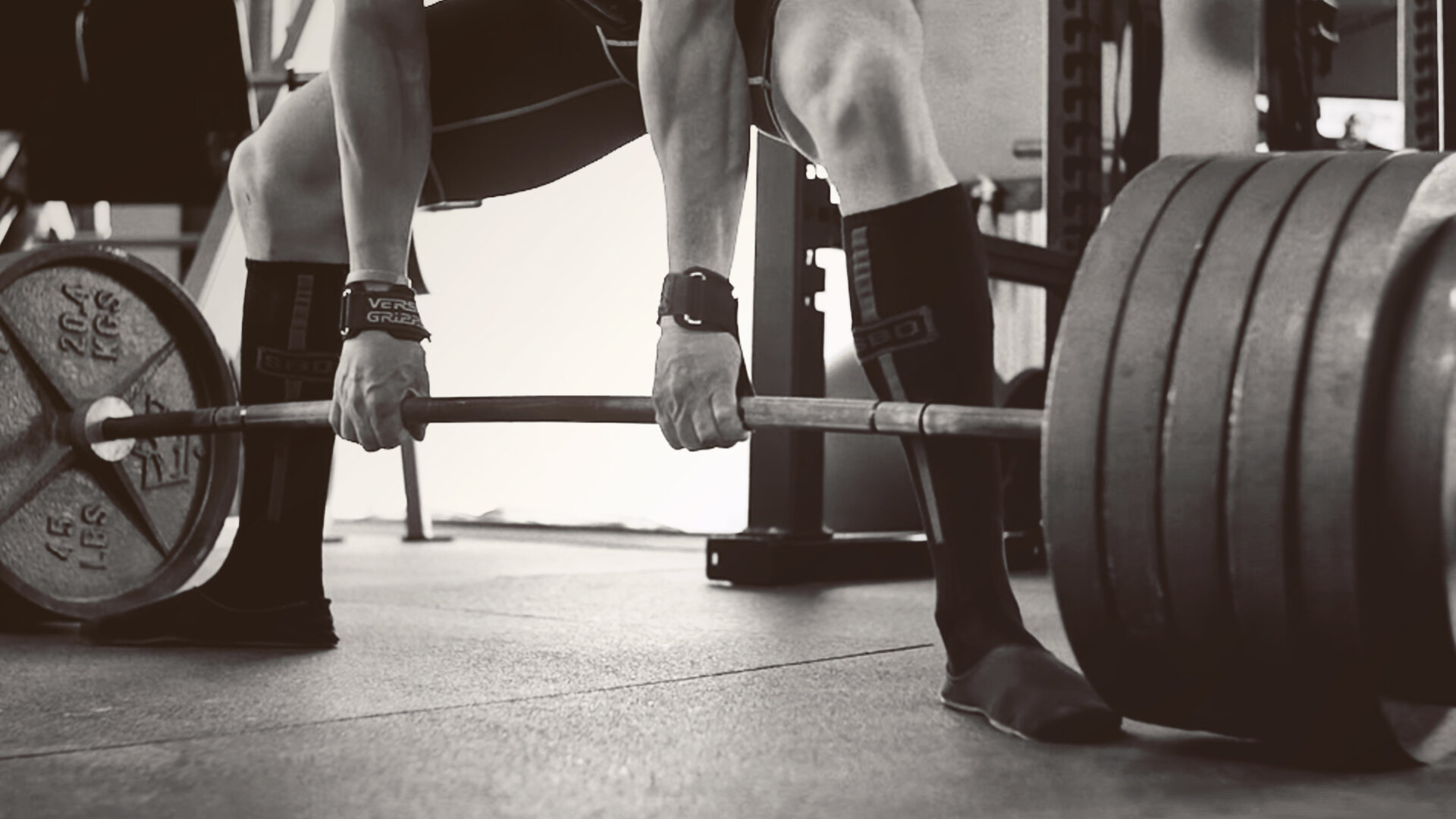Weak points are a bane to a solid deadlift. And there are three main areas where people fail. The first area you see often is off the floor. A lifter goes to pull, it rises a few inches and then nothing. It’s anti-climactic, and whether you’re in training or in a meet, it can ruin your day. The next common place is the midpoint. Often times it happens right about the knees, or right above them. And the last and most morale-killing sticking point is the lockout. You have already pulled it from the floor and you’re almost home free. But for some reason, you can’t make it. Then you drop the weight and walk away drowning in your shame. None of these are ideal scenarios and there are several reasons why you might be stuck at a given point. So let’s get into them.
Sticking Point: Off the Floor
There might be a few reasons for this. I’m going to assume you can budge the bar and that the weight isn’t too heavy for you. I’m also going to assume that your setup is halfway decent. So you’re the correct distance from the bar and the weight isn’t too heavy, but breaking the floor is still slow. So we have two potential culprits: your quads or your hamstrings.
The Quads
While the deadlift is less a quad exercise and more of a lift for your posterior chain, it doesn’t mean your quads are out of the whole picture. At the start, you will bend your knees more than in any other point in the lift, and straightening the knees requires your quads to flex. To that end, stronger quads will yield better starting strength. Given that you want to train in the most specific way, you want to strengthen your quads and get some quality pulling in.
So, there are are a few training options for you. The first option is to use a trap bar for some of your accessory work. A hybrid squat/deadlift, this pull puts a bit more emphasis on your quads, which you need if your sticking point is off of the floor. One other note on the trap bar: some trap bars have different grip options. One option has the handles higher which will lessen the range of motion on the lift. Or you can opt for the lower handle position which will increase the range of motion. While the lower option might be better for quad recruitment due to the extra range of motion, using the higher handle position won’t kill you. Do what you can at first.
If your gym doesn’t have a trap bar, you’re not out of luck. My personal favorite accessory movement is a deficit deadlift. If you are not familiar with it, it means that you extend the range of motion on the deadlift. Since the lockout is the ending point, the only place we can increase the range of motion is at the bottom. If your hamstrings are inflexible, the deficit which you use will be small. If you are capable, you can pull from a bigger deficit. As for options to increase the range of motion, you can use something as small as a 45lb plate, as big as a six-inch box, or you can load the bar with a bunch of 35lb plates. I like the latter option since it doesn’t require me to look around the gym for a box for a half an hour. As for the others, position them so that when you stand upon them, all you need to do is deadlift like you would any other time.
The Hamstrings
As I noted above, if your hamstrings are inflexible or weak, it will affect your deadlift as well. If they are inflexible and weak it will have an effect on the start of your pull. For instance, if they are inflexible you might find yourself rounding your back at the setup. So stretch them. Hamstring mobility and flexibility is a bigger topic than I can cover here, but some basic stretches will work wonders.
But for strengthening them, my favorite option is the glute-ham raise. In the video above I am improvising a glute-ham raise, but your gym might have the appropriate apparatus to make it easier for you. You’ll also notice that mine is a scaled down version of the movement in that I incorporate a lot of hip flexion in the exercise. Like with everything else, build upon it and make it better.
The Midpoint
If you have ever witnessed a good start to a deadlift only to see it deteriorate into something abominable at the lifter’s knees, they likely suffer from a weak midpoint. In a lot of cases, you start off with a decent amount of tension in the upper back, but it gives way, and you get stuck, and your upper back starts to round and you can’t move the weight unless there’s a miracle afoot. So, we have to strengthen that upper back. A great deadlift variation to help with that is the snatch grip deadlift. I didn’t do a video on this because it is like your normal deadlift. The difference is that your pinkies go on the rings, or somewhere close to them. As soon as you try it you’ll feel the upper back tension. And to reinforce it, you want to make sure you are squeezing your scapulae together the whole time. If at any time there is an energy leak, your form will break down and the tension will leave. If that’s the case, lower the weight.
One of the other cool things about the snatch grip deadlift is that, by default, it becomes a deficit deadlift. The wider the grip the greater the range of motion. So if you don’t have the mobility to pull from a deficit (fix that if you don’t) you can still get the benefits of the snatch grip deadlift. All you have to do is do them from the rack. Select an appropriate height and you’re good to go.
The last option is a good morning. For one thing, if you lose tension in your back, the bar will crush you. As an added bonus, this will help your hamstrings as well.
The Lockout
At the top of a deadlift, you are reaching maximum hip extension. If you have a weak set of glutes, extending your hips against significant load can be difficult. In some cases, it can keep you from locking it out. So if you are in the need for more powerful and stronger glutes, there is a remedy. And they might look more aesthetic as a result of these accessories, too. The first option is the glute pull through, or as the iPhone likes to say, “the flute pull through.” I like it because you can get a better feel for what the glutes need to do at the top of the deadlift, and you can hammer it home by using this drill.
Once you get the form down for that, another great option is the kettlebell swing. I included a video in the reference section on how to do them well, but suffice it to say, if you want a better deadlift, you don’t want to keep these light. However, when you first start out, keep them light to practice the form and the speed. As you progress, make them heavy. In an ideal world, every man or woman should be able to one day swing two 70lb kettlebells. Work on that and your deadlift will get better.
Last, you can train the lockout by doing heavy rack pulls from a point right above your knees, or right around your mid-thigh. Work your way up to using maximal or supramaximal weights, and you’re lockout will improve by leaps and bounds.
The Reverse Hyper
I mentioned a lot of deadlift accessories thus far, but one I haven’t mentioned deserves its own section. As you can see in the video, the model (Olivia) is using the machine and it emphasizes the hip extension component of the deadlift. But there’s more to it than that. Between gravity, heavy squats, and deadlift practice you are putting your spine through a lot of compression forces. The reverse hyper machine puts your spine into traction (the exact opposite of compression) and allows you to train hip extension that way. Moreover, your sacrum moves. In other gym movements, you don’t have that luxury.
As for the form, make sure you don’t hyperextend your lower back too much and focus on squeezing your glutes. In addition to that, if you have any issues with your hips you can try out two different loading patterns:
- Loop the band around your right leg
- Loop the band around your left leg
As for which you choose, you will perform the movement the exact same way. So the unloaded and the loaded leg are going to both be moving into extension. As time goes by, the necessity to switch legs will rear its head. So pay attention to those physiological cues. One final note on the reverse hyper, you’ll note that Olivia isn’t taking her time with it. To get the full benefit of the spinal traction, you want it to be fast. But don’t lose control, and don’t lose sight of the cues I mentioned above. Don’t forget to check the references, as well. There’s a video of Louis Simmons explain some variations in greater detail.
Conclusion
For the barbell lifts, I prefer opting for speed to blast through the sticking points. For the most part, if you are opting for speed, stay between the 60-70% 1RM range for these lifts. Given that you will be focusing on speed, it won’t take a lot of sets and reps at first. The first step is to assess your weak point and figure out where to go from there. Depending on where it is, that will dictate the exercises you choose. As for when to do them, since you aren’t training the specific lift, you can train them on a separate day compared to when you train the actual deadlift.

